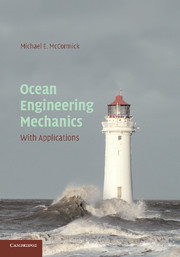Book contents
- Frontmatter
- Contents
- Preface
- Notation
- OCEAN ENGINEERING MECHANICS
- 1 Introduction
- 2 Review of Hydromechanics
- 3 Linear Surface Waves
- 4 Nonlinear Surface Waves
- 5 Random Seas
- 6 Wave Modification and Transformation
- 7 Waves in the Coastal Zone
- 8 Coastal Engineering Considerations
- 9 Wave-Induced Forces and Moments on Fixed Bodies
- 10 Introduction to Wave-Structure Interaction
- 11 Wave-Induced Motions of Floating Bodies
- 12 Wave-Induced Motions of Compliant Structures
- Appendices
- References
- Index
8 - Coastal Engineering Considerations
Published online by Cambridge University Press: 05 June 2012
- Frontmatter
- Contents
- Preface
- Notation
- OCEAN ENGINEERING MECHANICS
- 1 Introduction
- 2 Review of Hydromechanics
- 3 Linear Surface Waves
- 4 Nonlinear Surface Waves
- 5 Random Seas
- 6 Wave Modification and Transformation
- 7 Waves in the Coastal Zone
- 8 Coastal Engineering Considerations
- 9 Wave-Induced Forces and Moments on Fixed Bodies
- 10 Introduction to Wave-Structure Interaction
- 11 Wave-Induced Motions of Floating Bodies
- 12 Wave-Induced Motions of Compliant Structures
- Appendices
- References
- Index
Summary
The purpose of this chapter is to give a cursory introduction to shore protection and to discuss some topics that are normally neglected in the coastal engineering literature. By shore protection, what is meant is the methodologies used in preventing either a net erosion or a net accretion of beach sand due to wave action. Specifically, some of the considerations that are part of the planning phase of shore protection projects are discussed. Shore protection is one of the topics under the broad heading of coastal engineering. The reader is referred to the books by Horikawa (1978), U.S. Army (1994), Goda (1975), Sorensen (1997), Dean and Dalrymple (2002), and that edited by Herbich (1999) for a more thorough discussion of the area of ocean engineering. In addition, the proceedings of the International Coastal Engineering Conference contain papers describing advances in both the science and technology applied to the coastal zone. These conferences occur about every two years, and are sponsored in part by the American Society of Civil Engineers (ASCE).
Shore Protection Methods
When a shoreline is identified as being unstable, the term usually means that there is a net loss of sand (erosion) or net gain (accretion). The engineer must determine whether or not the instability is short-term or long-term. Short-term instabilities are common, and are usually seasonal in nature. Winter waves tend to erode beaches, whereas summer waves tend to restore sand to the beaches.
- Type
- Chapter
- Information
- Ocean Engineering MechanicsWith Applications, pp. 258 - 272Publisher: Cambridge University PressPrint publication year: 2009



